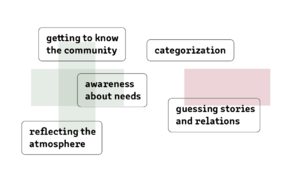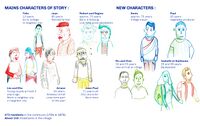LED2LEAP 2020 - Nuertingen Team 3
Jump to navigation
Jump to search
>>>back to working groups overview
| Area | Klein-Tischardt | |
| Place | Nürtingen | |
| Country | Germany | |
| Topics | Strengthening diversity and preserving traditions | |
| Author(s) | Leila Hoffmann, Carolin Lenz, Chiara Marquart, Vanessa Thaser | |
Landscape Democracy Rationale
- Klein-Tischardt is a very mixed district. Different social groups live there in different forms of housing. We see a particularly high need for public open space there. People from different backgrounds and different age groups demand the exchange with other people. For this purpose (open) space must be created. The existing, currently undeveloped building area represents a fragile centre of democracy. In case of doubt, it is here that it can decide whether or not citizens are to be given a say. Moreover, the quarter is crossed by a main traffic axis. This means that more people than just the Klein-Tschardt residents have an interest, whether social or economic, in the design of the quarter.
Location and scope
- map editor
- District Klein-Tischardt, 72622 Nürtingen
Phase A: Mapping your Community
Welcome to your community and its landscape
- district Klein-Tischardt between the rivers Neckar & Steinach
- main road divides KT in two
- buildings with rural character
- unused squares & closeness to the river offers potential
- agricultural background
- high diversity
- high average age
Groups of actors and stakeholders in your community
- more visible groups: senior citizens,citizen’s initiative, families & children, students, refugees, city initiative
- less visible groups: rowers club, small businesses, workers, gastronomy, tourists
Relationships between your actors and groups
- senior citizens play a dominant role in the area
- refugees are less present and dominant
- shared interests: attractive open spaces, meeting points, safe road spaces, space for representation, possibility for interaction, leisure activities
Summary of your learnings from the transnational discussion panel on April 22
- the scale of the projects are completely different
- different approaches to analyse, get to know different methods
- very in-depth informations about the communities through the analysis
- highly appealing graphics, which supported the comprehensibility of the presentation
Theory reflection
- Lynch, Kevin. (1960): The Image of the City, Cambridge, Mass.: MIT Press
- the image of the city - is a way of making the city more readable and working with defined tools that’s a very practical method to work with a city and we think a recognisable district supports the identity and community
- we see it critically to categorize the community so strongly in groups, for our analysis and design the individuals are crucial
- storytelling is a very identity supporting and creating method, we like how intensively you deal with the community but we find it difficult to guess the stories without getting in touch with the community
References
- traffic space - public space from Stefan Bendiks and Aglaée Degros Podcast The sooner now auf Spotify
- Lynch, Kevin. (1960): The Image of the City, Cambridge, Mass.: MIT Press
Phase B: Democratic Landscape Analysis and Assessment
The Scene in your Story of Analysis
- Describe your landscape democracy challenge. What is the physical scene, specific description of the landscape? What are the socio-economic and political characteristics of place? Are there any important contextual elements?
- add the corresponding visual from your presentation to the image gallery below
- Yourcase scene1.jpg
add a caption
The Actors in your Story of Analysis
- Describe the characters and their role in the story. Are they major or minor characters? Are there any key relationships that need to be defined?
- add the corresponding visual from your presentation to the image gallery below
The Story of Analysis
- Describe the plot of the story and how it plays out.
- add the corresponding visual from your presentation to the image gallery below
- add as many additional images as you like
- Yourcase story2.jpg
add a caption
Reflect on your Story of Analysis
- How did the tools you chose for landscape analysis fit your community? Reflect on the questions: What did you carry? Why did you carry? How did you carry? What remains after you've left? (150 words)
- add the corresponding visual from your presentation to the image gallery below
- Yourcase refelction1.jpg
add a caption
Phase C: Collaborative Visioning and Goal Setting
* template coming
Phase D: Collaborative Design, Transformation and Planning
* template coming
Phase E: Collaborative Design, Transformation and Planning
* template coming
= Phase E: Collaborative Evaluation and Future Agendas * template coming
Process Reflection
- Reflect in your intercultural and interdisciplinary team on the outcomes of your study
- Which limitations were you facing?
- What have you learnt from each other?
- What would you do differently next time?
- You can also use diagrams/visuals
- 250 words text









